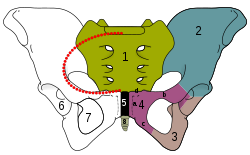Obturator foramen
| Obturator foramen | |
|---|---|
 Pelvis. Obturator foramen is 7. | |
 Symphysis pubis exposed by a coronal section. Obturator canal labelled at center. | |
| Details | |
| Identifiers | |
| Latin | foramen obturatum |
| TA98 | A02.5.01.008 |
| TA2 | 1314 |
| FMA | 16999 |
| Anatomical terms of bone | |
The obturator foramen (Latin foramen obturatum) is the large opening created by the ischium and pubis bones of the pelvis through which nerves and blood vessels pass.
Structure[]
It is bounded by a thin, uneven margin, to which a strong membrane is attached, and presents, superiorly, a deep groove, the obturator groove, which runs from the pelvis obliquely medialward and downward.
This groove is converted into the obturator canal by a ligamentous band, a specialized part of the obturator membrane, attached to two tubercles:
- one, the posterior obturator tubercle, on the medial border of the ischium, just in front of the acetabular notch
- the other, the anterior obturator tubercle, on the obturator crest of the superior ramus of the pubis
Variation[]
Reflecting the overall sex differences between male and female pelvises, the obturator foramina are oval in the male and wider and more triangular in the female.
Additionally, unilateral pelvis hypoplasia can cause differences in size between the obturator foramina, and there are even rare reports of individual pelvises featuring a double obturator foramen in one of the hip bones.[1]
Function[]
Through the canal the obturator artery, obturator vein and obturator nerve pass out of the pelvis.
See also[]
- Obturator internus muscle
- Obturator externus muscle
Additional images[]

The two circles at the bottom are the obturator foramina.

Variations in origin and course of obturator artery.

The relations of the femoral and abdominal inguinal rings, seen from within the abdomen. Right side.
Anterior view of the body pelvis
References[]
![]() This article incorporates text in the public domain from page 237 of the 20th edition of Gray's Anatomy (1918)
This article incorporates text in the public domain from page 237 of the 20th edition of Gray's Anatomy (1918)
- ^ Apostolos Karantanas; Konstantina Velesiotou & Evagelos Sakellariou (2002). "Double Obturator Foramen". American Journal of Roentgenology. Larissa General Hospital, Greece. 178 (1): 245. doi:10.2214/ajr.178.1.1780245. PMID 11756138.
External links[]
- Anatomy photo:17:st-0205 at the SUNY Downstate Medical Center - "Major Joints of the Lower Extremity: hip and sacrum (anterior view)"
- Atlas image: male_urethrogram at the University of Michigan Health System - "Pelvis & Perineum: Male Urethrogram"
- Photo at vc.cc.tx.us
- Wikipedia articles incorporating text from the 20th edition of Gray's Anatomy (1918)
- Pelvis
- Bones of the pelvis


